Whether you ride a road bike, commuter bike, mountain bike or a hybrid bike, you’ll most probably have gears. If you’re new to the world of geared cycles and you’re wondering how to ride a gear cycle, it can be pretty overwhelming to think of the numerous gears and when to shift them. Well, there’s no need to worry because we’ve put together a handy guide that incorporates all the things you’ll need to know about geared cycles and shifting gears.
First things first, what are gears and what is the use of gears in a cycle?
These mechanical wonders allow you to speed up and even pass different terrains smoothly, allowing you to power up a steep slope without bursting a lung. Getting a geared bike makes riding more comfortable and efficient whether you’re climbing mountains or cruising the streets in any city.
Basically, gears help in two ways:
1. When going uphill: When riding a normal cycle, you’ll have to put maximum effort going uphill, and you’re already at the highest speed you can be. With a geared bike, you can shift to a lower gear and pedal faster, allowing you to use less energy and putting less strain on yourself and the bike.
2. When going downhill: Shift to the top gear while pedalling at high speeds so as to reduce the RPM.
The next question that arises is:
How many gears does a cycle have? And, which gears to use on a bicycle?
Shifting gears can be confusing, so it’s always ideal to know which gear to use and when.
Most bikes have two sets of gears. Namely, the front gears called the chain rings and the rear gears called the rear cogs or sprockets.
1. Chainrings:
The front gears or chainrings are used to carry out heavy changes in the gears. The left shifter on the handlebar controls the front derailleur that shifts the chain between these chainrings. Here are a few tips to help you decide what gear works best for you and when to put it in use:
- The smallest chainring: Use this when you expect the going to get tough, like when you’re going uphill. So, to reach optimum speed, use the smallest chainring.
- The medium chainring: Use for regular cruising around the streets and flat terrains.
- The large chainring: When you want to and can go to high speeds, like when you’re riding downhill or on a smooth, flat road, the large chainring is ideal.
2.Rear Cogs:
These are used more often to make minor changes. The derailleur that shifts the chain up and down is controlled by the right shifter on the handlebar.
Remember: Right=Rear, Left=Front.
Bike Gears: The Basics
How do cycle gears work?
Bicycles have gears to make going uphill easier, and also to facilitate going faster on level ground.
One can think of gears as the same thing as speed. A bike with 7 gears is the same thing as a 7-speed bike. Lower numbers are lower gears, and higher numbers are higher gears. Shifting means going from one gear to another. The bicycle gear system works by sliding the shifter on the handlebars. A bicycle gear system involves Downshifting and Upshifting - Downshifting means going to a lower gear and Upshifting means going to a higher gear. This is also known as shift down and shift up.
The shifting basics: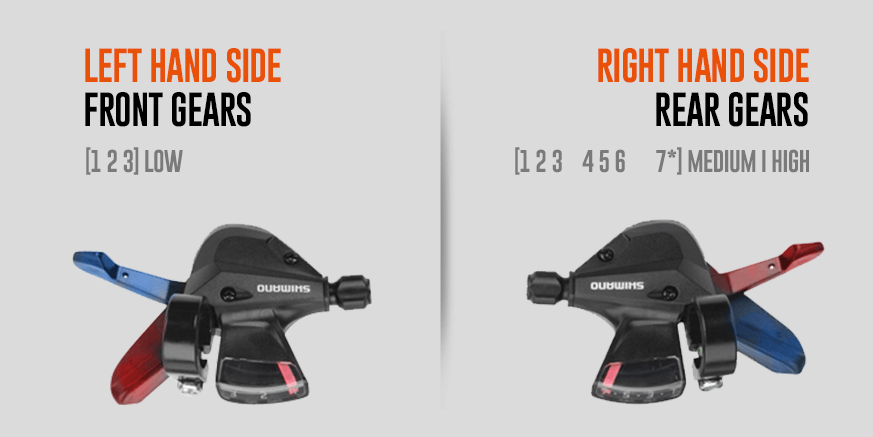
The left shifter changes the ring next to the pedals. When you downshift with the left shifter, you’re moving to a smaller ring. The smallest ring is 1, the middle ring is 2 and the biggest ring is 3.
The right shifter changes the ring on the rear wheel. This is the opposite of the front set. The biggest ring is 1 and the smallest ring is 6. You can downshift with either shifter, moving it from a higher number to a smaller number. However, you get a bigger change when you shift with the left-hand shifter rather than when you shift with the right-hand shifter.
It is important to change gears slowly and gradually. You’re prone to experience a lot of clunking and an increased risk in dropping your chain if you shift down from your biggest cog to your littlest cog in 5 seconds. The aim is to change gears one at a time, slowly clicking-up or down and pedalling in between the changes. Pedal softly when you change gears, especially on rough surfaces, as applying pressure mid change can result in you losing your chain.
How many gears do cycles have?
Bikes generally have 1, 3, 18, 21, 24 or 27 speeds. Different types of bikes have different number of gears. BMX and fixed gear bikes usually have a single gear. Road bikes usually have two cogs at the front and up to nine at the back, so eighteen gears. Mountain bikes have the biggest range of gears and variation in bikes. Mountain bikes have gear shifters between ten and thirty in total, since they can have one to three cogs on the front and up to ten on the back. Kids bikes can have anywhere from six to twelve gears.
How to use and change gears in your cycle?
Your bike will work in any combination of front and back gears. However, the right combination will feel really smooth and effortless. The three basic gear choices for smooth gear shifting are as follows:
Low Gear: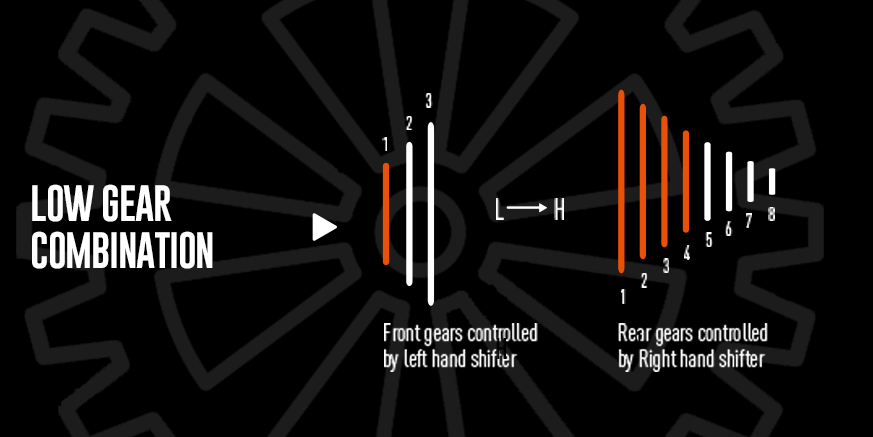
This gear is great for climbing. Switching down to this combination as you approach the climb will allow you to climb the hill slowly and steadily with less effort.
In this combination:
- Front gear = Small chainring
- Back gear = The largest sprockets (e.g. 1-3)
Normal Gear:
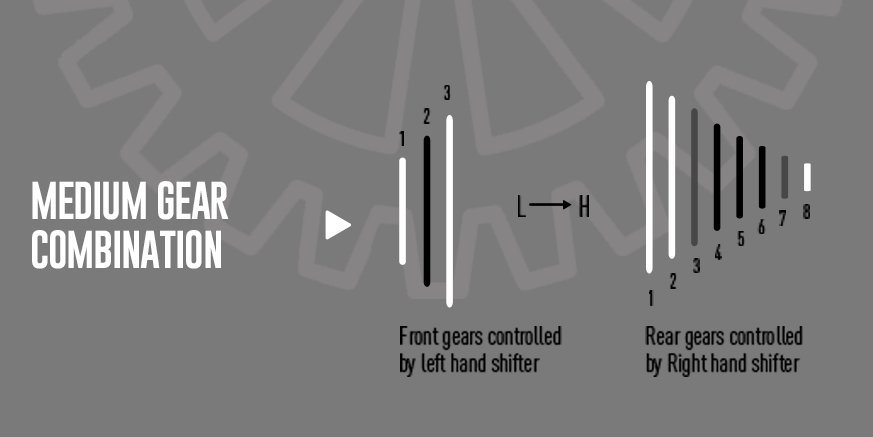
This gear is great for everyday terrain that does not offer too much resistance and can be used while cruising along a flat road or any undulating terrain. This is great when you want resistance, but not too much. You can flick between the rear gears to cater to changes when the road goes up and down a little bit.
In this combination:
- Front gear = Small chainring on double/compact or middle chainring on a triple
- Back gear = The middle sprockets (e.g. 3-6)
High Gear:
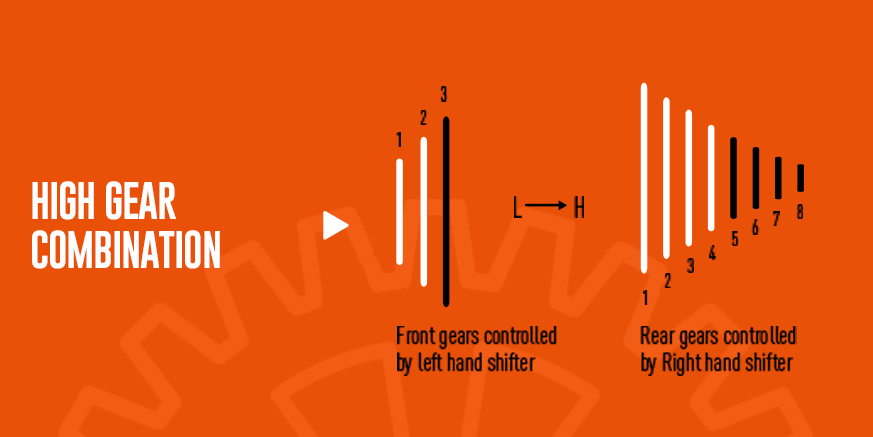
Top gear is great for descending, accelerating, or for when you want to go fast on a flat road. What happens in high gear is that you travel a longer distance for each pedal turn.
In this combination:
- Front gear = Big chainring
- Back gear = Smallest sprockets (e.g. 4-7)
When to shift gears on your bicycle?
When you’re just getting comfortable with your bike and the bike gear shifters, use only the rear cogs and the small or middle chainring. This will allow you to get the hang of it before you shift into harder gears. If you’re unsure of what gear you’re in, just take a quick look. A glance to the front confirms what ring you’re in, and a glance to the back will give you an idea as to whether you’re in a higher or lower gear.
What are the best gears to cycle in?
Shift to easier gears when climbing uphill or when you’re riding in the direction of the wind. Use a harder gear for flat terrains, or if the wind is blowing from behind - a tailwind situation.
If you’re in doubt, it is advisable to shift before a terrain change. This is especially applicable for hills or climbs. Shift gears in anticipation of the climb, not when you feel the incline kick in.
Once you’re more familiar, you can play with different gear combinations for different situations. While riding uphill or into a headwind, it is best to use the front chainring and bigger rear cogs. While riding downhill, use the middle or big front chainring and a range of rear cogs.
Do you shift gears while pedalling?
Completely stopping the pedalling will not allow you to shift gears at all. Reducing the tension and pedalling with a small force is ideal.
How to shift Shimano Gears?
The most popular group set among bike manufacturers today are the Shimano gear shifters. Shimano makes use of STI levers which stands for ‘Shimano Total Integration,’ wherein, the left shifter controls the front derailleur and the right shifter controls the rear derailleur.
What is cross-chaining and why to avoid it?
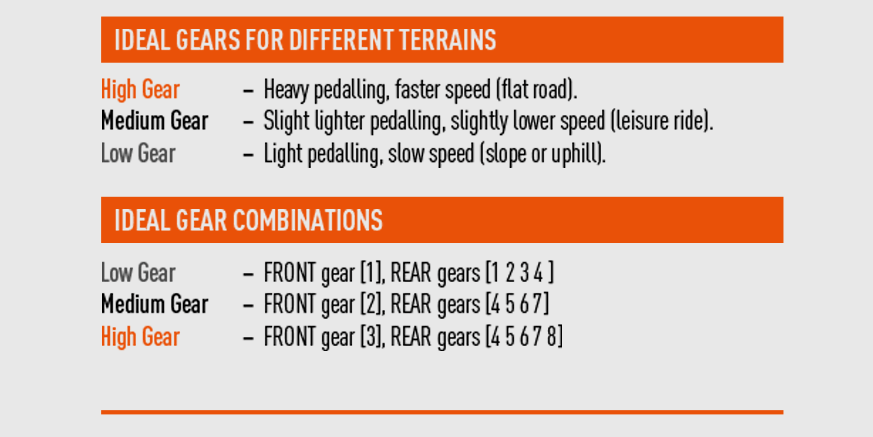
Cross-chaining is when you’re in your big chainring and the biggest cog, or on your small chainring and your smallest cog. The problem with this is that it stretches your chain diagonally to its limits, and seriously risks damaging your drivetrain. This is not an immediate problem, but will wear out both your rings and gears over time leading to costly repairs in the future.
Some important tips to remember when using a geared cycle:
1. Don’t shift too quickly:
While going downhill, it may be tempting to directly shift up to a higher gear, but this can cause the chain to jump off the gears completely. Shift gradually to make sure that the chain has engaged with each new gear before moving to the next one.
2. Left= big changes, right= fine tuning.
When you’re anticipating a climb, it's easier to use the left shifter. Once you are at an easier gear, you can then easily fine tune using the right shifter.
3. Anticipate the climb:
It’s important to anticipate the climb and shift gears before actually making the climb.
4. Don’t cross-chain:
Avoid staying on one chainring and only changing the gears at the back.
5. Practice makes perfect:
Get comfortable and understand how each combination of cogs and chainrings work. Spend some time getting used to changing different gears on different terrains. With practice, gear changing will come almost instinctively - so don’t stress and just practice until you’ve got it at your fingertips.




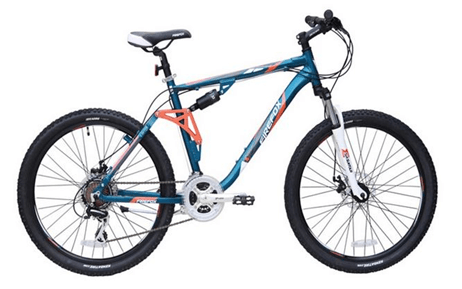
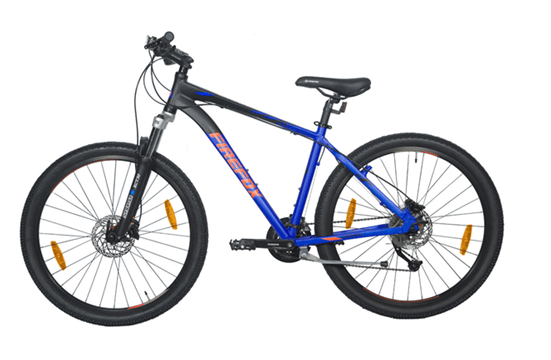
Sign in with